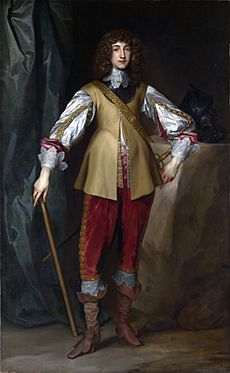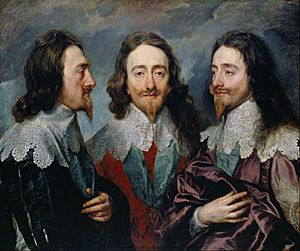Cavalier facts for kids

The word Cavalier was a nickname given to the supporters of King Charles I and his son Charles II of England. This happened during the English Civil War (1642 – c. 1679). At first, the King's opponents, called Roundheads, used "Cavalier" as an insult. But later, the Royalists (King's supporters) proudly used the name themselves.
While the term originally described a person's political views and behavior, it is now often linked to the fancy clothes worn by the King's court. Prince Rupert of the Rhine, who led many of King Charles I's horse soldiers, is seen as a perfect example of a Cavalier.
Contents
What Does "Cavalier" Mean?
The word "Cavalier" comes from a Latin word meaning 'horseman'. It is similar to words in other languages like the Italian cavaliere and the French chevalier, both meaning 'knight' or 'horseman'.
Long ago, the famous writer Shakespeare used a similar word, cavaleros, to describe a bold or swaggering person.
Cavaliers in the English Civil War
The term "Cavalier" is most famous for its link to the Royalist supporters of King Charles I. These were the people who fought against Parliament in the English Civil War.
The word first appeared as a way to insult the King's followers in June 1642. People said that "Cavaliers" were men who did not care about laws or God. They were ready to cause trouble and violence.
King Charles I himself said that "Cavalier" was a word that seemed "much in disfavour." But soon, the King's side took the name for themselves as a badge of honor. In return, they called their opponents "Roundheads."
After the war, the King's party kept the name. It was used until a new term, "Tory", became popular.
How People Saw Cavaliers
At the time, "Cavalier" was not just about how someone dressed. It described a whole way of thinking and behaving. However, today, the word is often connected to the stylish clothes of that period.
Cavalier fashion included long, curly hair, brightly colored clothes with fancy lace collars and cuffs, and hats with feathers. This was very different from the simpler clothes and shorter hair preferred by some of Parliament's supporters, the Roundheads.

Many Parliamentarian generals actually wore their hair long, similar to the Royalists. Even Oliver Cromwell, a famous Parliamentarian leader, was an exception with his shorter hair. Some of the most important people who supported King Charles I's painter, Sir Anthony van Dyck, actually fought for Parliament in the war.
The famous painting Laughing Cavalier by Frans Hals shows a gentleman from a Dutch town. This painting, from 1624, is often seen as showing a "cavalier" style.
The King's chaplain, Edward Simmons, described a Cavalier as a "Child of Honour." He said they were gentlemen who loved their king and had a "bolder look" because of their loyal hearts. Many Royalist officers fit this description. They were often in their early thirties, married, and managed country estates. Even though they had different religious views from some of Parliament's soldiers, faith was important to them.
A good example of this type of Cavalier was Jacob Astley, 1st Baron Astley of Reading. Before the Battle of Edgehill, he famously prayed, "O Lord, Thou knowest how busy I must be this day. If I forget Thee, do not forget me."
After the first part of the Civil War, Astley promised not to fight against Parliament again. Because he gave his word, he felt he could not help the Royalist side in the second part of the war.
However, the Roundheads also used "Cavalier" as a negative word in their propaganda. They painted a picture of a Cavalier as someone who was wild, drank a lot, and rarely thought about God. This image has lasted through history. Some Royalists, like Henry Wilmot, 1st Earl of Rochester, did fit this wild description.
Another Royalist general, George Goring, Lord Goring, was described by Edward Hyde, 1st Earl of Clarendon as someone who would do anything to get what he wanted. He was very good at pretending to be something he wasn't.
Today, the word "cavalier" can describe a careless or overly casual attitude, but still with a hint of style. The term "Cavalier" was used for supporters of the monarchy until the Exclusion Crisis (1678–1681). After that, the term "Tory" took its place. "Tory" was also first used as an insult. Similarly, "Roundhead" was replaced by "Whig" during the same time.
Cavaliers in Art

You can see the Cavalier style in paintings like Charles I, King of England, from Three Angles by Anthony van Dyck. This painting shows the King in different poses, highlighting the fashion of the time.
Images for kids
-
An old picture showing King Charles I and his supporters.
See also
 In Spanish: Cavalier (apodo) para niños
In Spanish: Cavalier (apodo) para niños



